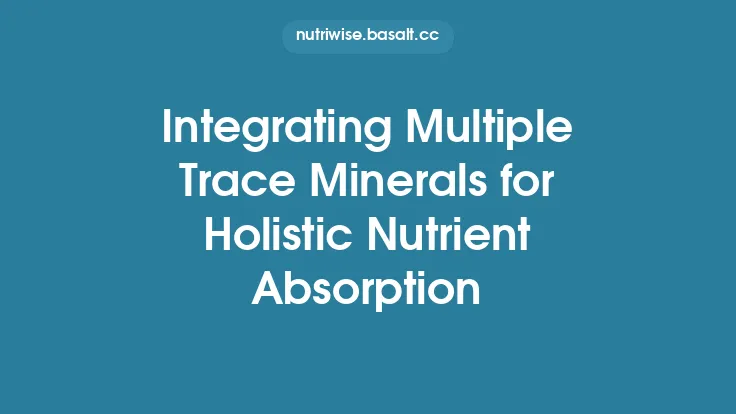The human gastrointestinal (GI) tract is more than a simple conduit for food; it is a dynamic, highly regulated ecosystem where digestion, absorption, and metabolic signaling intersect. The health of this system—encompassing the structural integrity of the intestinal lining, the composition and activity of the gut microbiota, and the coordinated function of digestive enzymes and transport proteins—plays a decisive role in determining how efficiently nutrients become bioavailable to the body. Below, we explore the key mechanisms by which gut health influences nutrient absorption, the factors that can disrupt these processes, and evidence‑based strategies to support optimal gut function.
The Architecture of the Intestinal Barrier
1. Epithelial Cell Turnover and Tight Junctions
The intestinal epithelium is a single layer of enterocytes that renews itself every 3–5 days. This rapid turnover is essential for maintaining a tight barrier that regulates paracellular (between‑cell) transport. Tight junction proteins—claudins, occludin, and zonula occludens (ZO) proteins—seal the spaces between cells, preventing uncontrolled leakage of luminal contents into the submucosa. When tight junction integrity is compromised (a condition often termed “leaky gut”), nutrients can be lost into the lumen or, conversely, antigens and toxins can trigger inflammation that impairs absorptive capacity.
2. Brush Border Enzymes
The apical surface of enterocytes is studded with brush border enzymes (e.g., lactase, sucrase‑isomaltase, maltase, peptidases). These enzymes hydrolyze complex carbohydrates, disaccharides, and small peptides into absorbable monosaccharides and amino acids. Deficiencies or down‑regulation of these enzymes—whether genetic (e.g., lactase non‑persistence) or acquired (e.g., due to inflammation)—directly limit the amount of substrate available for transport.
3. Transporter Proteins and Carrier-Mediated Uptake
Nutrient uptake across the enterocyte membrane relies on a suite of transporter proteins:
- SGLT1 (Sodium‑Glucose Linked Transporter 1) – actively transports glucose and galactose together with sodium.
- PEPT1 (Peptide Transporter 1) – mediates di‑ and tripeptide uptake.
- NPC1L1 (Niemann‑Pick C1‑Like 1) – critical for cholesterol and sterol absorption.
- DMT1 (Divalent Metal Transporter 1) – imports ferrous iron (though iron is not the focus here, the principle applies to other divalent minerals).
The expression and activity of these transporters are modulated by hormonal signals (e.g., GLP‑2), nutrient status, and microbial metabolites.
The Gut Microbiota: A Metabolic Partner
1. Fermentation and Short‑Chain Fatty Acids (SCFAs)
Commensal bacteria ferment indigestible carbohydrates (dietary fibers, resistant starches) into SCFAs—acetate, propionate, and butyrate. SCFAs serve several functions relevant to nutrient absorption:
- Energy Source for Colonocytes: Butyrate fuels the cells lining the colon, supporting barrier integrity.
- Regulation of Transporter Expression: SCFAs up‑regulate SGLT1 and PEPT1, enhancing glucose and peptide uptake.
- Modulation of Hormone Secretion: SCFAs stimulate enteroendocrine cells to release GLP‑1 and PYY, which influence gut motility and nutrient transit time.
2. Microbial Synthesis of Vitamins and Cofactors
Certain gut bacteria synthesize B‑group vitamins (e.g., biotin, folate, riboflavin) and vitamin K2. While the contribution of microbial synthesis to overall status varies among individuals, a healthy microbiome can provide a supplemental source of these micronutrients, especially when dietary intake is marginal.
3. Bile Acid Metabolism
Primary bile acids secreted by the liver are deconjugated and transformed into secondary bile acids by intestinal microbes. These secondary bile acids influence micelle formation, a prerequisite for the absorption of fat‑soluble nutrients (e.g., carotenoids, fat‑soluble vitamins). Dysbiosis can alter bile acid pools, thereby affecting the efficiency of micellar solubilization and subsequent uptake.
Inflammation and Immune Interactions
1. Cytokine‑Mediated Barrier Disruption
Pro‑inflammatory cytokines such as TNF‑α, IL‑1β, and IFN‑γ can down‑regulate tight junction proteins and brush border enzymes, leading to increased permeability and reduced absorptive capacity. Chronic low‑grade inflammation—common in conditions like irritable bowel syndrome (IBS) or metabolic endotoxemia—therefore directly impairs nutrient bioavailability.
2. Immune Cell Crosstalk with Enterocytes
Mucosal immune cells (e.g., dendritic cells, macrophages) release mediators that can either enhance or suppress transporter expression. For instance, IL‑22 promotes epithelial regeneration and up‑regulates antimicrobial peptides, indirectly supporting a healthier barrier and more efficient absorption.
Motility, Transit Time, and Nutrient Contact
The rate at which luminal contents move through the small intestine determines the exposure time of nutrients to absorptive surfaces. Both hypermotility (as seen in diarrheal states) and hypomotility (as in constipation) can diminish absorption:
- Rapid Transit: Reduces the time for enzymatic hydrolysis and transporter-mediated uptake.
- Slow Transit: May lead to bacterial overgrowth, increased deconjugation of bile acids, and competition for nutrients.
Neuro‑hormonal pathways—including the enteric nervous system and hormones such as motilin—coordinate peristalsis and segmentation, ensuring optimal mixing and contact.
Factors That Compromise Gut‑Mediated Absorption
| Factor | Mechanism of Disruption | Typical Consequences |
|---|---|---|
| Antibiotic Use | Alters microbial composition, reduces SCFA production, impairs bile acid transformation | Decreased transporter expression, reduced vitamin synthesis |
| Chronic Stress | Increases cortisol, alters gut permeability, modifies motility | Leaky gut, impaired enzyme activity |
| Non‑steroidal Anti‑Inflammatory Drugs (NSAIDs) | Direct epithelial injury, disrupts tight junctions | Microscopic ulceration, malabsorption |
| Infections (e.g., Giardia, C. difficile) | Damage to villi, inflammation, altered microbiota | Short‑term malabsorption of multiple nutrients |
| Dietary Patterns Low in Fiber | Reduces substrate for SCFA production, diminishes microbial diversity | Weaker barrier, lower transporter up‑regulation |
Strategies to Support Gut Health for Optimal Nutrient Absorption
1. Diversify Dietary Fiber
Incorporate a mix of soluble (e.g., oats, legumes, psyllium) and insoluble (e.g., whole grains, nuts) fibers to fuel a broad spectrum of microbial taxa. This promotes robust SCFA production and maintains mucosal health.
2. Include Prebiotic‑Rich Foods
Compounds such as inulin, fructooligosaccharides (FOS), and galactooligosaccharides (GOS) selectively stimulate beneficial bacteria (e.g., Bifidobacterium, Lactobacillus). Regular consumption can enhance brush border enzyme activity and transporter expression.
3. Consider Targeted Probiotic Supplementation
Strains with documented effects on barrier function—*Lactobacillus rhamnosus GG, Bifidobacterium longum, Saccharomyces boulardii*—may reduce intestinal permeability and modulate immune signaling, thereby supporting absorption.
4. Optimize Meal Timing and Composition
Consuming moderate‑size meals spaced evenly throughout the day prevents overwhelming the absorptive capacity of the small intestine and allows adequate time for enzymatic breakdown. Pairing complex carbohydrates with a modest amount of protein can synergistically stimulate SGLT1 and PEPT1 activity.
5. Manage Stress and Sleep
Mind‑body practices (e.g., meditation, yoga) and adequate sleep (7–9 hours) lower cortisol levels, which in turn preserve tight junction integrity and maintain normal motility patterns.
6. Limit Unnecessary NSAID Use
When pain relief is required, consider alternative agents (e.g., acetaminophen) or use the lowest effective NSAID dose for the shortest duration, supplemented with gastroprotective strategies (e.g., co‑administration of a proton pump inhibitor if clinically indicated).
7. Re‑Establish Microbiota After Antibiotics
Following a course of broad‑spectrum antibiotics, a short period of probiotic supplementation combined with a high‑fiber diet can accelerate microbiota recovery, mitigating the temporary dip in absorptive efficiency.
Emerging Research Directions
- Personalized Microbiome‑Based Nutrition: Metagenomic profiling is being explored to predict individual responses to specific dietary fibers and to tailor interventions that maximize nutrient uptake.
- GLP‑2 Analogs: Synthetic glucagon‑like peptide‑2 analogs are under investigation for their ability to enhance mucosal growth and transporter expression in patients with short bowel syndrome.
- Targeted Modulation of Bile Acid Receptors (FXR, TGR5): Pharmacologic activation of these receptors may improve micelle formation and, consequently, the absorption of fat‑soluble nutrients.
Bottom Line
Gut health is a cornerstone of nutrient bioavailability. The integrity of the intestinal barrier, the functional capacity of brush border enzymes and transporters, the metabolic activities of a diverse microbiota, and the regulation of inflammation and motility together dictate how effectively the body extracts and utilizes the nutrients we ingest. By fostering a resilient gut environment through dietary diversity, mindful supplementation, stress management, and prudent medication use, we can enhance the efficiency of nutrient absorption and support overall health.





